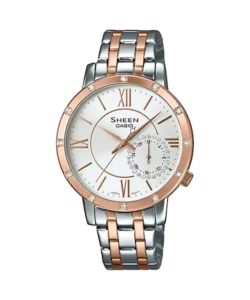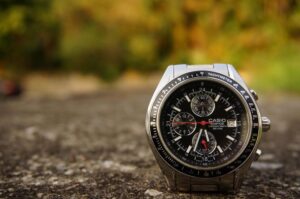Seiko watches ‘made in japan’ vs ‘made in Malaysia’
Seiko Group is a well-known Japanese company that manufactures watches and other time-keeping devices. It has a reputation for producing reliable and accurate timepieces, earning the title ‘Japan’s No.1 Watch Brand from International Watch magazine.
Seiko has expanded its production activities from being strictly in Japan and has extended its facilities to Malaysia. This has caused questions to arise as regards the quality of these Malaysian-made watches compared to those made in Japan.
Is there any difference between Seiko made in Japan vs Malaysia?
The primary differences between both models are the labeling on the case and the language used for the time/date display.
In terms of functionality, there is no difference between the watches made in Japan and the watches made in Malaysia.
Seiko uses the same automation and machinery in both facilities, so all watches go through the same production processes and under the same quality check standards.
Another difference between the two models is that ‘J’ (Japanese) models have an English/Arabic day display, while ‘K’ (Malaysian) models have an English/Spanish display.
There are a few cases where ‘K’ models may have an English/Arabic display. This happens in some models, which were made in Japan, but branded ‘K’ because of the market it is intended to be sold to. This multilingual display feature is because of the countries in which such watches are intended to be marketed.
Where does Seiko make their watches?
Before launching its production facility in Malaysia, all parts and movements were manufactured in Japan alone.
For efficiency purposes, the company has spread these processes among facilities in certain countries.
The watches are assembled in Japan, regardless of which of the two countries produced the watch. Production of parts is shared across their facilities in Japan, Malaysia, Singapore, and Hong Kong.
For example, the watch cases are largely made in Hong Kong while the bands/bracelets are made in China. This is why some Seiko watches carry the ‘made in China’ label on the bands.
Some parts of the movements are gotten from Hong Kong. The lower-end movements are made in Malaysia or Hong Kong but high-end movements are made strictly in Japan.
The watches produced in Malaysia are made under very strict supervision and policies, so they do not leave room for any products to be below the Japanese standard.
Are there different prices for Japan\Malaysia Seiko?
Japanese Seiko has a slightly higher price than Malaysian Seiko even though there is no functional difference between both models. Japanese Seiko attracts a slightly higher premium and is viewed as more desirable than its Malaysian counterparts. There is a perceived superior quality of Japanese workmanship.
The price difference is also incited by the fact that there is a higher demand for the J watches than the K watches. This is based on some misconceptions that tend to portray Malaysian-made watches as less in quality than Japanese-made watches. Some buyers also feel that if they were to buy watches from a Japanese brand, then they should be made in Japan.
The price difference between both models is a maximum of 10 – 20 %. For example, if a ‘K’ model is $450, the ‘J’ model should cost between $495 -$540.
Are rumors right, Seiko made in Japan is better?
The rumors that Seiko made in Japan is better than Seiko made in Malaysia are false. Seiko uses the same machinery and parts to assemble and manufacture their watches in Malaysia, even down to the robots.
There isn’t any proof that one is better than the other. There aren’t specific problems that are limited to Japanese models or Malaysian models. The reason why Japanese models are highly demanded is just because of sentiments, and the reasoning that if a watch should be made by a Japanese-based country, then the watch should be made in Japan.
Some people just get a kick out of knowing that their watches are JDM or made in Japan versions.
Is there an accuracy difference between Seiko’s Japanese, Malaysian, or Singapore movements?
The watch’s movement is the most important part of a watch. Without the movement, a watch cannot tell time. And for a watch to be perfectly working, it’s time telling has to be accurate.
Since Seiko gets its movements from Japan, Malaysia, and Singapore, the question of accuracy arises often.
There is no accuracy difference between the Seiko’s Japanese, Malaysian, and Singapore movements. All movements are fine for their watches. You will get long life, easy repair, and decent accuracy out of either one. Though none of them are as highly accurate as Swiss movements, Seiko has greatly calibrated these movements with cutting-edge technology and passed them through different testing stages to ensure their accuracy before casing them.
Is build quality the same in all Seiko watches?
In terms of build quality, the J models and K models are the same. All watches are produced and assembled by robots with the same programming, and just located in different countries. This debunks the rumor that Japanese watches are of better quality than Malaysia’s. Many have also assumed that the quality control methods are poorer in Malaysia, but Seiko fans with both models have assured the public that such claims are false.
At the end of the day, it doesn’t matter where the watch is made, it is the technology that counts. For Seiko, everything from the raw materials to the oils is made by them or their subsidiaries. All machinery and factory regulations and procedures are Seiko’s, so there is no importance if the watch was made in Malaysia or Japan because the build quality is the same.
Which countries get which model?
J and K models were intended for different markets. The different markets worldwide have various labeling laws. Some countries require products to be marked with the country of manufacture before being accepted into the country.
The J model is made for the Asian/Mid-Eastern markets, like Singapore, China, and Hong Kong, but is surprisingly scarce within the Japanese Domestic Market (JDM). The higher demand for J models has made the company focus on satisfying international clients rather than focusing on the home markets. The second-hand market has also aided the J models to gain access to countries where they aren’t supposed to be.
Many watch collectors will buy a used J Seiko from across the world to add to their collection.
The K models are usually intended for the European and US markets. At large, the K models are found in countries where the J models are not accepted. The USA does not allow the importation of Japanese-made Seiko watches into the country, therefore, the Malaysian models are a good market there. K models are also accepted in Russia, Germany, the United Kingdom, Albania, Estonia, and Croatia, among other European countries.
Does a Seiko say Made in Japan?
Seiko’s that are MIJ will have ‘MADE IN JAPAN’ printed between the 6 and 7 o’clock markers.
Japan Trademark Laws are not very strict and hence, a watch made on foreign soil can still be marked MIJ. Products are generally allowed to be stamped with Made in Japan if they are produced outside the national boundaries as long as they are produced by a wholly-owned Japanese national.
How can I tell where my Seiko was made?
It is always important to know where your watch originates from and with Seiko watches, it is quite easy. You can tell where your watch was made by looking at the serial number and observing the language of the time display.
Seiko models that end with J (e.g. SYMG35J1, SKX009J) are normally made in Japan. These watches normally have an English/Arabic day display and have a ‘made in Japan’ label at the bottom of the dial whereas Seiko models that end with K (e.g. SYMG35K1, SKXOO9K) are made in Malaysia. These watches mostly have an English/Spanish day display, but some have been found to also possess an English/Arabic day display.
Both models can be differentiated by looking at the rotor. If the watch is made in Japan, the rotor will have the word’ Japan’. For Example, a Japan-made watch can be labeled’ 4R36A Twenty Three Jewels Japan’.
You can also use the Seiko Serial number, in conjunction with the movement number (the four-digit number on the case back of all Seiko and Grand Seiko watches) to calculate the year of manufacture.
Conclusion
Seiko understands the need to look classy and own watches that are durable. This is why, regardless of where the watches are produced, your watch would always be on time and look sophisticated, with great quality. So, we recommend that if you are interested in buying a Seiko watch, just purchase the one readily available and affordable to you, as all Seiko watches are the same.
*add english\arabic and english\spanish image


